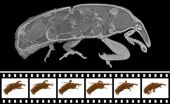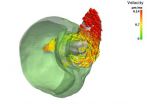(Press-News.org) This news release is available in German.
How does the hip joint of a crawling weevil move? A technique to record 3D X-ray films showing the internal movement dynamics in a spatially precise manner and, at the same time, in the temporal dimension has now been developed by researchers at ANKA, KIT's Synchrotron Radiation Source. The scientists applied this technique to a living weevil. From up to 100,000 two-dimensional radiographs per second, they generated complete 3D film sequences in real time or slow motion. The results are now published in the Proceedings of the National Academy of Sciences (PNAS) DOI: 10.1073/pnas.1308650111.
Three-dimensional radiographs represent internal structures, but do not provide any information about movement sequences. Conventional computer tomography is not efficient enough to reproduce movement in a spatially precise manner and, at the same time, in the temporal dimension. Every individual three-dimensional image, called tomogram, is reconstructed from hundreds of two-dimensional radiographs. "To produce highly resolved tomograms at such recording speed, we had to adjust every setting screw, from the X-ray source to the pixel detector and we optimally attuned all process steps to each other," Tomy dos Santos Rolo says. The doctoral student is the leading developer of the experimental setup. By making the 3D image frequencies approach the image rates known for 2D cine films, he reached the world record in high-speed tomography, i.e. a real 3D film with microscopic magnification.
For scientific evaluation, the three-dimensional contours of anatomic structures have to be clearly visible. This is achieved by the so-called phase contrast. If highly parallel X-rays pass the biological examination object, wave optics phenomena occur, which highlight the inner and outer contours.
"It is these contours that matter to us. We want to distinguish individual functional elements that move relative to each other. That is why we need sharp contours," Alexey Ershov, the expert for image analysis in the team, says. From the X-ray source to movement analysis, all process stages are designed to filter out image noise without reducing contrast. This also applies to the mathematic algorithms optimized for radiography. They reconstruct three spatial and one temporal dimension and derive exact movement patterns from the data.
In line with the first moving images – cinematography –, the scientists call their method "cinetomography". In the late 19th century, movements of big animals were studied. Today, researchers can analyze internal biological processes of small organisms, as is now demonstrated for the recently discovered screw joint of the weevil. Insects, spiders, and crustaceans make up more than 80% of all species.
Cinetomography cannot only be used to image in four dimensions biological and biotechnological processes, but also combustion processes relevant to industry.
INFORMATION:
Tomy dos Santos Rolo, Alexey Ershov, Thomas van de Kamp, and Tilo Baumbach: In vivo X-ray cine-tomography for tracking morphological dynamics, PNAS Early Edition (2014), DOI: 10.1073/pnas.1308650111
Karlsruhe Institute of Technology (KIT) is a public corporation according to the legislation of the state of Baden-Württemberg. It fulfills the mission of a university and the mission of a national research center of the Helmholtz Association. Research activities focus on energy, the natural and built environment as well as on society and technology and cover the whole range extending from fundamental aspects to application. With about 9000 employees, including nearly 6000 staff members in the science and education sector, and 24000 students, KIT is one of the biggest research and education institutions in Europe. Work of KIT is based on the knowledge triangle of research, teaching, and innovation.
This press release is available on the internet at http://www.kit.edu.
3-D X-ray film: Rapid movements in real time
Interdisciplinary team of researchers at KIT reaches new record in high-speed computer tomography -- Example: 4-D tomography of living weevil / publication in PNAS
2014-03-14
ELSE PRESS RELEASES FROM THIS DATE:
Patient requests for specific drugs have major impact on prescribing, reports study in Medical Care
2014-03-14
Philadelphia, Pa. (March 14, 2014) – Patient requests for specific medications—including requests for brand-name drugs spurred by direct-to-consumer (DTC) advertising—have a substantial impact on doctors' prescribing decisions, suggests a study in the April issue of Medical Care. The journal is published by Lippincott Williams & Wilkins, a part of Wolters Kluwer Health.
"A patient request for a specific medication dramatically increases the rate at which physician s prescribe that medication," according to the new research led by John B. McKinlay, PhD, of New England ...
Lurking in the darkness of Chinese caves 5 new species of armored spiders come to light
2014-03-14
Armored spiders are medium to small species that derive their name from the complex pattern of the plates covering their abdomen strongly resembling body armor. Lurking in the darkness of caves In Southeast China, scientists discover and describe five new species of these exciting group of spiders. The study was published in the open access journal ZooKeys.
The common name armored spiders is given to the engaging family Tetrablemmidae. Distinguished by their peculiar armor-like abdominal pattern, these tropical and subtropical spiders are mainly collected from litter ...
Dartmouth researchers develop new approach to chronic lymphocytic leukemia treatment
2014-03-14
March 14, 2014 Lebanon, NH - Dartmouth researchers have developed a novel and unique approach to treating Chronic Lymphocytic Leukemia (CLL), a form of blood cancer that often requires repeated chemotherapy treatments to which it grows resistant. The researchers, led by Alexey V. Danilov, MD, PhD, assistant professor at the Geisel School of Medicine at Dartmouth and Hematologist-Oncologist at the Norris Cotton Cancer Center, modeled the lymph node microenvironment where CLL cells are found in the laboratory. They were able to disrupt the activity of a pathway (NF-kappaB) ...
Bone lengthening technique proves useful in patients with cleft palate
2014-03-14
Philadelphia, Pa. (March 14, 2014) - A technique called distraction osteogenesis can create increased length of the upper jaw in patients with cleft lip and palate deformities, reports a study in the March issue of The Journal of Craniofacial Surgery, edited by Mutaz B. Habal, MD, published by Lippincott Williams & Wilkins, a part of Wolters Kluwer Health.
Distraction Technique Used to Lengthen the Palate
Dr. Emeka Nkenke of Erlangen University Hospital, Germany, and colleagues, report on the use of distraction osteogenesis to lengthen the maxilla (upper jaw) bone in ...
Big data tackles tiny molecular machines
2014-03-14
HOUSTON – (March 13, 2014) –Open, feed, cut. Such is the humdrum life of a motor molecule, the subject of new research at Rice University, that eats and excretes damaged proteins and turns them into harmless peptides for disposal.
The why is obvious: Without these trash bins, the Escherichia coli bacteria they serve would die. And thanks to Rice, the how is becoming clearer.
Biophysicists at Rice used the miniscule machine – a protease called an FtsH-AAA hexameric peptidase – as a model to test calculations that combine genetic and structural data. Their goal is to ...
Older adults: Build muscle and you'll live longer
2014-03-14
New UCLA research suggests that the more muscle mass older Americans have, the less likely they are to die prematurely. The findings add to the growing evidence that overall body composition — and not the widely used body mass index, or BMI — is a better predictor of all-cause mortality.
The study, published in the American Journal of Medicine, is the culmination of previous UCLA research led by Dr. Preethi Srikanthan, an assistant clinical professor in the endocrinology division at the David Geffen School of Medicine at UCLA, that found that building muscle mass is ...
New cell line should accelerate embryonic stem cell research
2014-03-14
Researchers at the University of Washington have successfully created a line of human embryonic stem cells that have the ability to develop into a far broader range of tissues than most existing cell lines.
"These cells will allow us to gain a much greater understanding of normal embryonic development and have the real potential for use in developing ways to grow new tissues and organs for transplantation," said Carol Ware, a professor in the UW Department of Comparative Medicine and lead author of a paper describing the new cell line appearing in the March 10 issue ...
Motion and muscles don't always work in lockstep, researchers find in surprising new study
2014-03-14
RIVERSIDE, Calif. — Animals "do the locomotion" every day, whether it's walking down the hall to get some coffee or darting up a tree to avoid a predator. And until now, scientists believed the inner workings of movement were pretty much the same — the nerves send a message to the muscles and there is motion.
But in a first-of-its-kind study on wild green anole lizards, biologists at the University of California, Riverside have discovered that the link between muscle function and movement is a lot more complicated than anyone realized.
"We were trying to understand ...
Critical role of one gene to our brain development
2014-03-14
Research from the University of Adelaide has confirmed that a gene linked to intellectual disability is critical to the earliest stages of the development of human brains.
Known as USP9X, the gene has been investigated by Adelaide researchers for more than a decade, but in recent years scientists have begun to understand its particular importance to brain development.
In a new paper published online in the American Journal of Human Genetics, an international research team led by the University of Adelaide's Robinson Research Institute explains how mutations in USP9X ...
Drivers with hemianopia fail to detect pedestrians
2014-03-14
BOSTON (March 14, 2014) — A diagnosis of hemianopia, or blindness in one half of the visual field in both eyes as the result of strokes, tumors or trauma often means the end of driving.
In about half of the states in the United States and in many other countries, driving with hemianopia is prohibited. However, in some countries including Belgium, the Netherlands, the UK, Switzerland and Canada, driving with hemianopia is permitted after passing a specialized road test. Researchers at Massachusetts Eye and Ear/Schepens Eye Research Institute set out to determine the extent ...
LAST 30 PRESS RELEASES:
Tracing the quick synthesis of an industrially important catalyst
New software sheds light on cancer’s hidden genetic networks
UT Health San Antonio awarded $3 million in CPRIT grants to bolster cancer research and prevention efforts in South Texas
Third symposium spotlights global challenge of new contaminants in China’s fight against pollution
From straw to soil harmony: International team reveals how biochar supercharges carbon-smart farming
Myeloma: How AI is redrawing the map of cancer care
Manhattan E. Charurat, Ph.D., MHS invested as the Homer and Martha Gudelsky Distinguished Professor in Medicine at the University of Maryland School of Medicine
Insilico Medicine’s Pharma.AI Q4 Winter Launch Recap: Revolutionizing drug discovery with cutting-edge AI innovations, accelerating the path to pharmaceutical superintelligence
Nanoplastics have diet-dependent impacts on digestive system health
Brain neuron death occurs throughout life and increases with age, a natural human protein drug may halt neuron death in Alzheimer’s disease
SPIE and CLP announce the recipients of the 2025 Advanced Photonics Young Innovator Award
Lessons from the Caldor Fire’s Christmas Valley ‘Miracle’
Ant societies rose by trading individual protection for collective power
Research reveals how ancient viral DNA shapes early embryonic development
A molecular gatekeeper that controls protein synthesis
New ‘cloaking device’ concept to shield sensitive tech from magnetic fields
Researchers show impact of mountain building and climate change on alpine biodiversity
Study models the transition from Neanderthals to modern humans in Europe
University of Phoenix College of Doctoral Studies releases white paper on AI-driven skilling to reduce burnout and restore worker autonomy
AIs fail at the game of visual “telephone”
The levers for a sustainable food system
Potential changes in US homelessness by ending federal support for housing first programs
Vulnerability of large language models to prompt injection when providing medical advice
Researchers develop new system for high-energy-density, long-life, multi-electron transfer bromine-based flow batteries
Ending federal support for housing first programs could increase U.S. homelessness by 5% in one year, new JAMA study finds
New research uncovers molecular ‘safety switch’ shielding cancers from immune attack
Bacteria resisting viral infection can still sink carbon to ocean floor
Younger biological age may increase depression risk in older women during COVID-19
Bharat Innovates 2026 National Basecamp Showcases India’s Most Promising Deep-Tech Ventures
Here’s what determines whether your income level rises or falls
[Press-News.org] 3-D X-ray film: Rapid movements in real timeInterdisciplinary team of researchers at KIT reaches new record in high-speed computer tomography -- Example: 4-D tomography of living weevil / publication in PNAS






